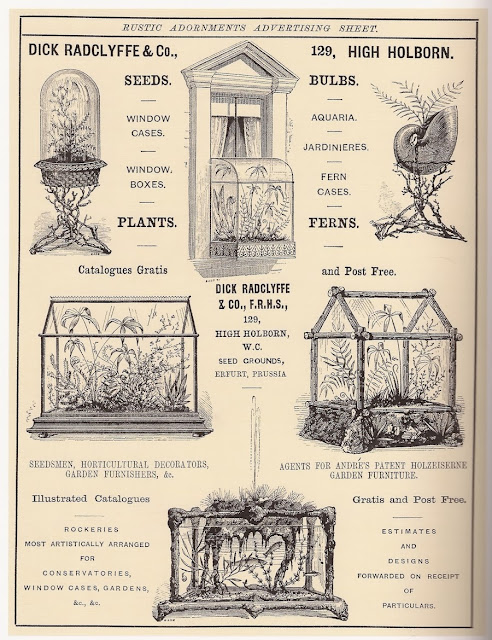 |
| Bell jar style terrarium ad, from the book "Fern Fever" |
Sarah Whittingham traces this phenomenon in her glossy book "Fern Fever: The Story of Pteridomania." Jam packed with lush photos of ferneries, fern grotto gardens, and decorative arts graced with fern fronds, she forms an overwhelming set of evidence for the Victorian fern fever, or pteridomania.
Interestingly enough, young women embraced fern fever the most avidly of all Victorians. Much like the pop star-crazed tweens of today, Victorian teens were engrossed in trading fern specimen collector cards and begging their parents to install fern grottoes in their basements. Even the daughter of novelist Charles Dickens developed mild pteriodomania.
An excerpt from the book:
The novelist Charles Dickens was sometimes irritated by his daughter Mary's lack of vigour and purpose in life. In 1862 he wrote to a friend to whom Mary (then aged 24) had expressed a wish for some ferns to plant in their home:
"After careful cross examining my daughter . . . I do NOT believe her to be worthy of the fernery . . . When I ask her where she would have the fernery and what she would do with it, the witness falters, turns pale, becomes confused, and says: 'Perhaps it would be better not to have it at all."
 |
| "Fern Fever: The Story of Pteridomania" by Sarah Whittingham |
Incidentally, all these ferns necessitated all sorts of fern cases, aquariums, terrariums and other methods of constructing suitable environments for the precious and often costly fern specimens. I share a few copies of the advertisements for Victorian fern cases from the book.







50+ Blackbuck's HD Pictures - World Fastest 6th Land Animals
ReplyDeleteThis is great.
ReplyDelete